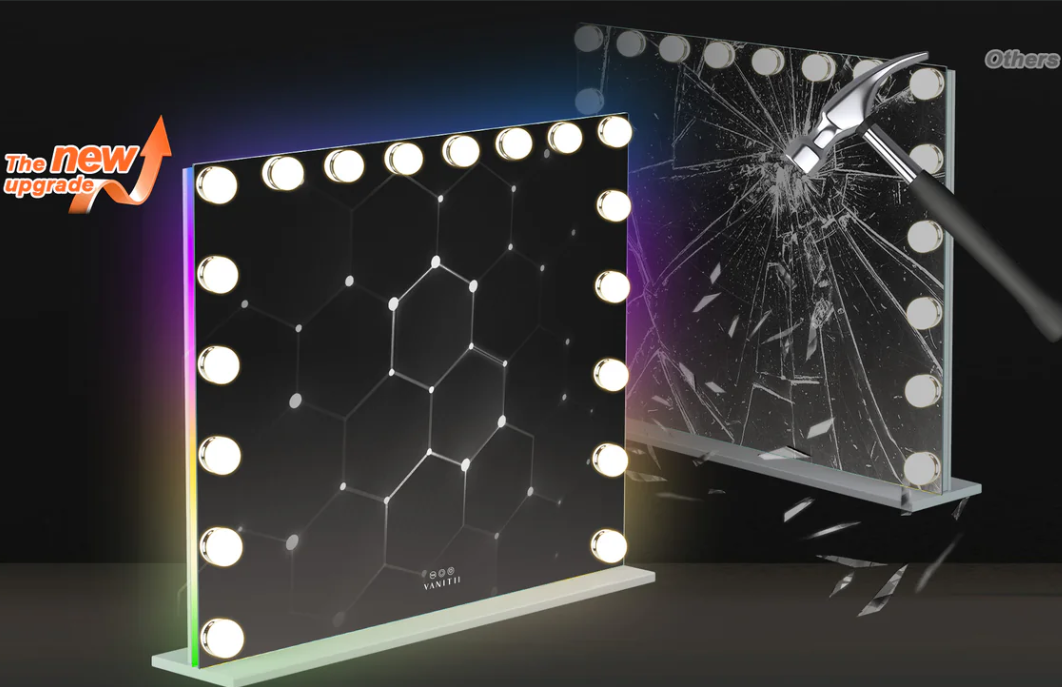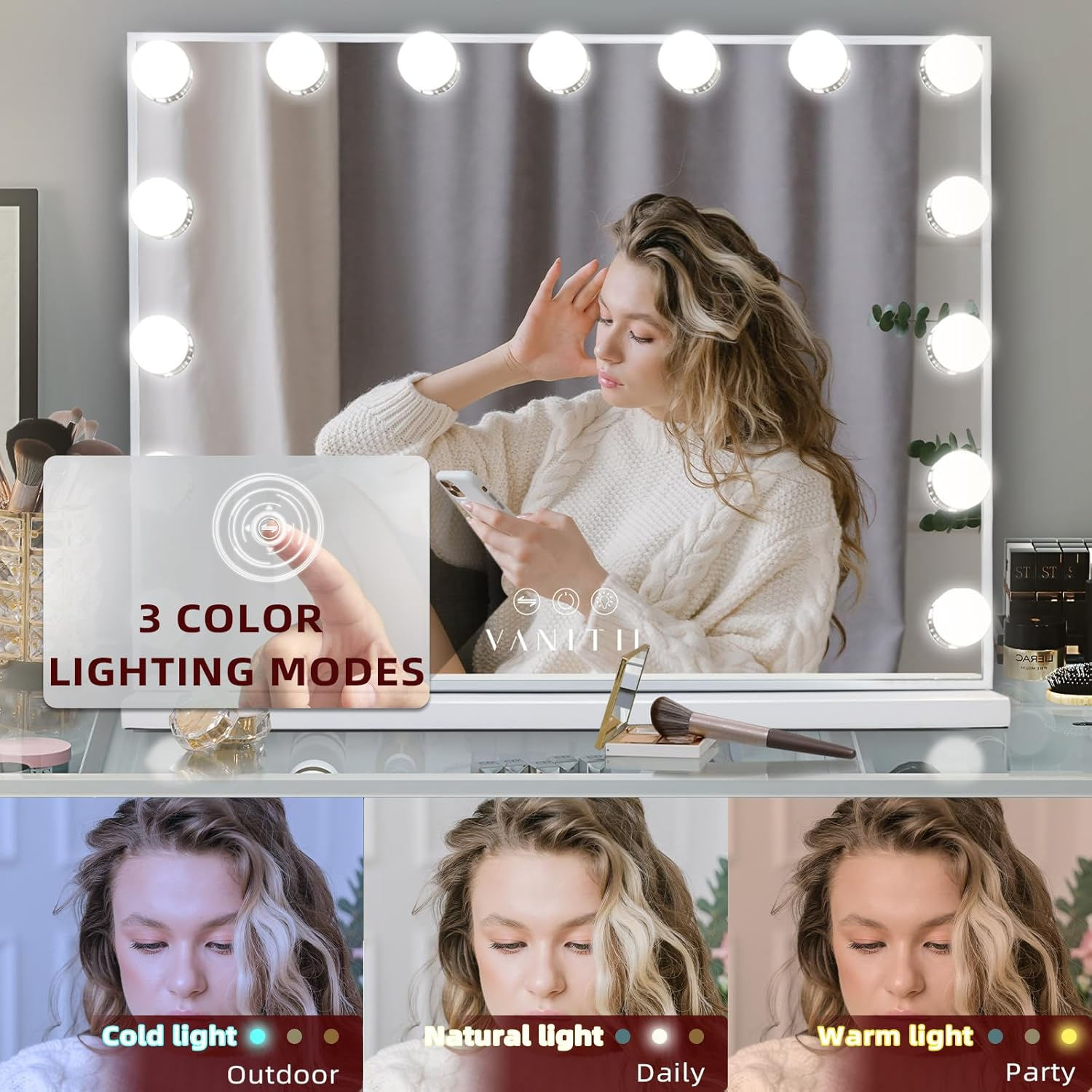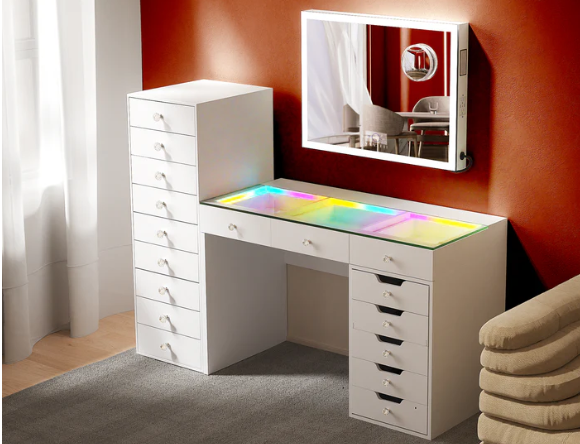Tempered glass is stronger and safer than regular glass, which matters for your safety at home. It's especially important if you're putting up new mirrors or checking old ones. Tempered glass breaks into small, less dangerous pieces if shattered, while regular glass can form large, sharp shards. This difference is crucial in bathrooms or areas where accidents might happen. Understanding your mirror's glass type helps you make smart choices about where to use it and how to handle it. This knowledge isn't just interesting—it could help prevent injuries and ensure you're using the right mirror for each space in your home.
Tempered Glass Mirrors: Everything You Need to Know
Tempered glass mirrors are specially made to be stronger and safer than regular glass mirrors. Here's what makes them different:
How Tempered Glass Mirrors are Made
Tempered glass mirrors go through a unique process. First, the glass is cut to the right size for the vanity mirror. Then, the edges are smoothed to prevent cracks. Next, the glass is heated to very high temperatures. Finally, it's cooled quickly with cold air. This process makes the glass about four times stronger than regular glass. If it breaks, it forms small, dull pieces instead of sharp shards.
Why Choose Tempered Glass Mirrors?
Tempered glass mirrors offer several advantages. They're much harder to break and can handle temperature changes better. If they do break, the small pieces are less likely to cause serious injuries. Their strength allows for bigger mirrors without frames, giving more design options. They also work well in bathrooms or near heat sources because they're heat resistant.
Tempered glass mirrors are often used in bathrooms, gyms, and other busy areas because of these benefits. They're a good choice when you want a mirror with LED that's both safe and long-lasting. Click to read more:Tempered glass mirrors.
Visual Inspection Techniques for Tempered Glass Mirrors
You can often tell if a mirror is made of tempered glass by looking closely at it. Here are three ways to check:
1. Edge Inspection
Look at the edges of the mirror. Tempered glass mirrors usually have smooth, rounded edges. If you see tiny scratches or rough spots along the edge, it's likely tempered. Regular glass mirrors often have sharper, more polished edges.
2. Surface Markings
Check for any marks on the mirror's surface. Manufacturers often put small stamps or etchings in the corners of tempered glass mirrors. These marks might include the word "tempered" or "safety glass," or show the manufacturer's logo. Sometimes, you'll see a code that indicates the safety standard the glass meets.
3. Distortion Analysis
Hold the mirror at an angle and look at the reflection. Tempered glass mirrors might show slight waves or distortions in the reflection. This is due to the heating and cooling process used to make them. Regular glass mirrors usually have a flatter, more even reflection.
Physical Testing Methods for Tempered Glass Mirrors
If visual inspection isn't conclusive, there are some physical tests you can try. However, be cautious with these methods, especially the last one.
1. Polarized Light Test
This test uses polarized sunglasses to reveal hidden patterns in tempered glass. Hold the polarized glasses in front of your eyes and look at the mirror. Rotate the glasses slowly. If the mirror is tempered, you might see dark, shadowy lines or patterns appear. These patterns show the stress in the glass from the tempering process. Regular glass won't show these patterns.
2. Stress Pattern Observation
In a dark room, hold the mirror at an angle under fluorescent light. Look closely at the surface. Tempered glass often shows faint, dark lines or patterns. These are called "quench marks" and are created during the rapid cooling process of tempering. You might need to tilt the mirror at different angles to see these marks.
3. Fragmentation Test (Not Recommended)
This test involves breaking the glass to observe its shatter pattern. Tempered glass breaks into small, cube-like pieces, while regular glass forms large, sharp shards. However, this test is dangerous and destroys the mirror. It should only be done by professionals in controlled conditions. Never try this at home, as it can cause serious injury.

Technological and Professional Identification of Tempered Glass Mirrors
When simple tests aren't enough, there are more advanced methods to identify tempered glass mirrors. These methods often require special tools or expert knowledge.
1. Glass Thickness Gauges
Glass thickness gauges are special devices that can help identify tempered glass. These tools measure not just the thickness of the glass, but also its density and composition. Tempered glass often has slightly different measurements than regular glass due to the tempering process. Some advanced gauges can detect the unique stress patterns in tempered glass. While these devices are accurate, they're usually used by professionals rather than homeowners.
2. Seeking Professional Assessment
If you're still unsure about your mirror, it's best to consult a glass professional. These experts have the knowledge and tools to accurately identify tempered glass. They might use:
- Specialized scanners that detect internal stress patterns
- Advanced light reflection tests
- Professional-grade thickness gauges
Glass professionals can also provide documentation certifying the type of glass, which can be important for safety regulations or insurance purposes. While this option might cost more, it provides the most reliable results and peace of mind.
Legal and Compliance Considerations for Tempered Glass Mirrors
When using tempered glass mirrors in bedrooms or other living spaces, there are still important legal and safety considerations to keep in mind.
Building Codes and Standards
While bathrooms often have strict requirements for tempered glass, other areas of the home may also have regulations:
- Large mirrors: Many codes require tempered glass for mirrors above a certain size, regardless of location.
- Sliding closet doors: Mirrored sliding doors often need to be tempered.
- Mirrors near high-traffic areas: Hallways or entryways might require tempered glass mirrors for safety.
Check your local building codes for specific requirements. These can vary by region, but many follow guidelines set by national or international building standards.

Legal Implications of Incorrect Identification
Using the wrong type of glass can still have consequences, even in bedrooms or living areas:
- Safety Concerns: Large mirrors that aren't tempered could pose a risk if broken.
- Liability Issues: If someone is injured by a broken non-tempered mirror, you could be held responsible.
- Insurance Considerations: Some home insurance policies may have specific requirements for glass types in certain applications.
While the rules might be less strict than in bathrooms, it's still important to use the right type of glass mirror for each situation. When in doubt, choosing tempered glass is often the safer option.
Safety Precautions When Examining Tempered Glass Mirrors
When trying to determine if your mirror is made of tempered glass, safety should be your top priority. Even simple inspection methods can pose risks if not done carefully.
Handling Mirrors Safely
Always treat mirrors with caution, regardless of whether they're tempered or not. Support the mirror fully when moving it and avoid putting pressure on corners or edges. Work on a stable, flat surface to prevent accidents. Never attempt to break the mirror for testing purposes. Even if a mirror is tempered, it can still cause injury if mishandled or dropped.
Protective Gear
When examining mirrors closely, it's wise to use protective equipment. Wear safety glasses or goggles to protect your eyes from potential chips or cracks. Use gloves to guard against cuts and improve grip. Wear closed-toe shoes in case of accidental drops. For more involved inspections, consider wearing long sleeves and pants to protect your skin.
Creating a Safe Environment
Before you start any examination, ensure you have good lighting to avoid straining your eyes or missing potential hazards. Clear the area of obstacles that might cause you to trip or bump the mirror. Keep children and pets away from the inspection area to prevent accidents.

Know Your Mirror to Take the Safe Route
Figuring out if your mirror is tempered glass is important for your safety. You can check by looking closely at the edges, surface marks, or using special tools. But always be careful when handling mirrors. Tempered glass is stronger and safer, breaking into small pieces instead of sharp shards. This matters in busy areas or where accidents might happen. If you're not sure, ask a professional. Using the right mirror in the right place keeps you and your family safe. It's better to be safe than sorry when it comes to glass in your home.




Leave a comment
This site is protected by hCaptcha and the hCaptcha Privacy Policy and Terms of Service apply.